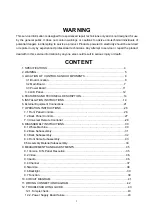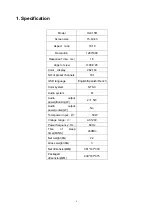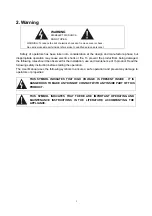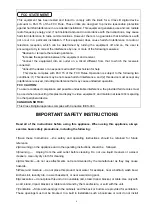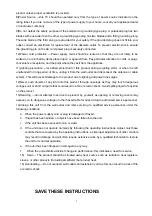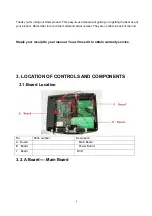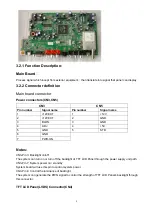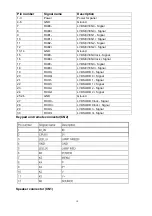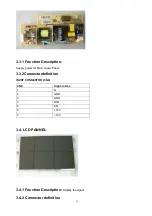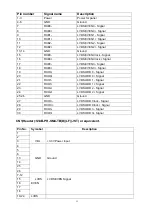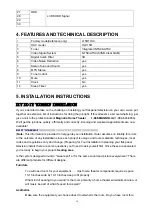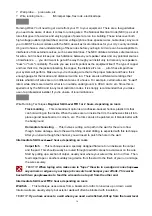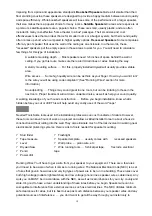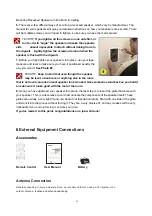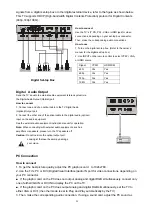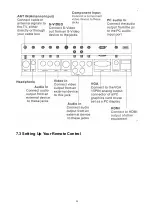
16
? Wall probe
—
piano wire, etc
? Wire running tools
—
fish/carpet tape, flex rods, electrical tape
Running Wires You'll need to get a wire from your TV to your equipment. There are a few guidelines
you need to be aware of when it comes to running wires: The National Electrical Code (NEC) is a set of
rules that govern how wires and varying types of power are run in a building. These rules cover both
high voltage (outlets, light switches) and low voltage (phone lines, speaker wires, cable lines). Any work
you do MUST be in accordance with the NEC, as well as local ordinances for your city, county and state.
It's good to have a clear understanding of these rules before you begin. A/V wire can be susceptible to
interference from external sources, such as electrical lines. The NEC dictates minimum safe clearances
for wires, but it is best to keep as much distance between your speaker wires and any potential sources
of interference
—
you don't want to get all the way through your install only to discover your speakers
"buzz" or "hum" constantly. The wire you use is as important as the equipment itself. The type of copper
and how thick it is, the jacket protecting the copper, the distance it's run
—
all of these impact how
your system will perform. Make sure you're choosing wire that is the proper material and has a thick
enough gauge for the location and distance it will be run. There are also different wire ratings that
dictate what kind of wires are run in different areas of a house. For example, certain wires are "in-wall"
rated, while others are rated for what is run outside, underground, in HVAC ducts, etc. Since this is
spelled out by the NEC and in any local restriction codes, it is strongly recommended that you make
use of a professional installer if you're unsure of local ordinances.
Wire Running Techniques
Beginner Skill Level
—
1 or 2 hours, depending on room
Track molding
—
This concealment option is an adhesive-backed, hollow, plastic trim that
can hold wiring on the inside. When the wires are run inside the trim, the adhesive sticks it into
place against baseboards, in corners, etc. The trim can also be painted, so it blends better with
the background.
Horizontal channeling
—
This involves cutting out a path in the wall for the wire to flow
though. Some damage, due to the wall notching or stud drilling, is expected with this technique.
After you run wire though the channel, you will need to patch the hole in the wall.
Intermediate Skill Level
—
2 hours, depending on room
Carpet fish
—
This technique uses a specially designed flat wire to run between the carpet
and the pad. This should usually be routed through low-traffic areas to avoid wear on the wire.
Start by pulling up a section of carpet, usually near where your wire will be run to or from. Then,
feed carpet tape or another suitably long device from the start to the finish of your run and tape
the wire securely.
TECHTIP:
When taping wire, make sure to "taper" the wire in a wedge or cone shape
—
any corners or edges on your tape job can catch and hamper your efforts. This works
best with two people
—
one to feed the wire and one to pull from the other end.
Intermediate Skill Level
—
2 hours, depending on room
Wall fish
—
This technique uses access from a basement or attic to run wires up or down a wall.
Interior walls are usually empty, but exterior walls will often be blocked with insulation.
TECHTIP:
If you have access to a wall where you need a wire fished, drill up from the lower level
Summary of Contents for HLC15R - 15" LCD TV
Page 1: ...1 HLC15R TV 8888 128 ...
Page 3: ...3 12 3 Main board failure check 44 12 4 Pannel failure 44 12 MAINTENANCE 47 ...
Page 27: ...27 7 2 Back panel controls ...
Page 28: ...28 7 3 Setting Up Your Remote Control ...
Page 29: ...29 ...
Page 39: ...39 9 6 Backlight Backlight adjust the backlight 9 7 Function Burning Mode ...
Page 56: ...42 11 WIRING CONNECTION DIAGRAM ...
Page 62: ...48 Sincere Forever ...

